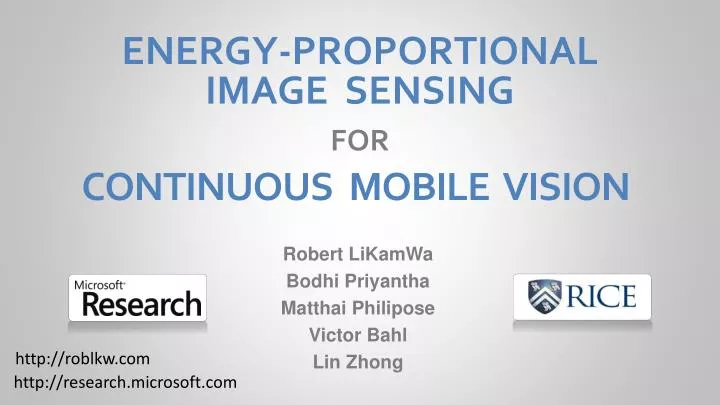Energy Characterization and Optimization of Image Sensing Toward Continuous Mobile Vision
![]() Download
Download

Skip this Video
Loading SlideShow in 5 Seconds..
ENERGY-PROPORTIONAL IMAGE SENSING FOR PowerPoint Presentation


ENERGY-PROPORTIONAL IMAGE SENSING FOR
Download Presentation
ENERGY-PROPORTIONAL IMAGE SENSING FOR
- - - - - - - - - - - - - - - - - - - - - - - - - - - E N D - - - - - - - - - - - - - - - - - - - - - - - - - - -
Presentation Transcript
-
ENERGY-PROPORTIONAL IMAGE SENSINGFOR CONTINUOUS MOBILE VISION Robert LiKamWa Bodhi Priyantha MatthaiPhilipose Victor Bahl Lin Zhong http://roblkw.com http://research.microsoft.com
-
Conversational Face Detection CONTINUOUS MOBILE VISION CONTINUOUS VISION MOBILE The Devil Wears Prada
-
Object Memory Victor Face Recognition CONTINUOUS MOBILE VISION CONTINUOUS VISION MOBILE Gestures Fine-grained Localization
-
BATTERY DEATH BATTERY LIFE GoPro Hero 2-3 hours LooxCie 2-3 hours Google Glass 2-3 hours
-
2000 mWh 200 mW 10 h
-
Image Sensor Goal < 25 mW Sensors ~ 5 mW Network Stack ~20 mW Processor ~150 mW
-
Image Sensor Goal < 25 mW Image Sensor Reality > 250 mW
-
KEY IDEA: ENERGY α QUALITY Power Power Frame rate Resolution
-
ENERGY PROFILE OF AN IMAGE SENSOR Goal: < 25 mW 1 MP, 15 fps 295 mW 1 MP, 5 fps 250 mW 0.3 MP, 15 fps 245 mW 0.3 MP, 5 fps 232 mW > 230 mW Reality:
-
ENERGY-EFFICIENTIMAGE SENSING Image Sensor Characterization Energy Reduction Techniques Energy vs. Vision Performance
-
IMAGE SENSOR MEASUREMENT * Camera Module Power Power Rail Resistors VDD CLK Programmable Clock (I2C) NI DAQ Device * Profiled 5 state-of-the-art image sensors from 2 manufacturers
-
IMAGE SENSOR MEASUREMENT Camera Module Power Rail Resistors Programmable Clock (I2C) NI DAQ Device
-
IMAGE SENSOR WAVEFORMS Active Period Analog Idle Period Digital PLL
-
IMAGE SENSOR WAVEFORMS Active Period Idle Period
-
IMAGE SENSOR WAVEFORMS Active Period Pixel Countdivided by Clock Frequency Idle Period Frame Time minus Active Time
-
IMAGE SENSOR PIXEL COUNT (N) Scaled Resolution (Pixel Skipping) Region-of-Interest (Windowing) Active Active Power Power Time Time
-
IMAGE SENSOR PIXEL COUNT (N) Video (30 FPS) Power vs. Resolution Active Active Power Power Time Time
-
IMAGE SENSOR FRAME RATE (R) Active Active Frame Readout Active Active Active Active Active Power Time 1.0s Active Frame Readout Active Active Power Video (0.1 MP) Power vs. FPS Time
-
CHARACTERIZATION CONCLUSION:NOENERGY PROPORTIONALITY Video (30 FPS) Power vs. Resolution Video (0.1 MP) Power vs. FPS
-
ENERGY-EFFICIENTIMAGE SENSING Image Sensor Characterization Energy Reduction Techniques Energy vs. Vision Performance
-
TECHNIQUE #1: AGGRESSIVE STANDBY Active Active Active Active
-
AGGRESSIVE STANDBY CAVEAT TO Active Active Active Active This won't work for long active periods, i.e., high resolution, high frame rate. Active Active Not enough exposure time
-
TECHNIQUE #2: CLOCK SCALING (f) One pixel per clock period
-
TECHNIQUE #2: CLOCK SCALING (f) Lower Active Time Higher Active Power Faster clock Higher Idle Power Higher Active Time Lower Active Power Slower clock Lower Idle Power
-
TECHNIQUE #2: CLOCK SCALING (f) Active Low Pixel Count Low Frame Rate Active Slowed Clock Optimal clock frequency depends onPixel Count & Frame Rate
-
AGGRESSIVE STANDBY + CLOCK OPTIMIZATION Active Readout Aggressive Standby Active Read out Sped-up Clock Optimal clock frequency depends onPixel Count & Frame Rate Exposure Time
-
ENERGY α QUALITY Aggressive Standby & Clock Optimization Unoptimized 30 30 350 350 25 25 300 300 250 250 20 20 200 200 Power (mW) Power (mW) Frame rate (FPS) Frame rate (FPS) 15 15 150 150 10 10 100 100 5 5 50 50 0 0 0 0 1 2 3 4 5 1 2 3 4 5 Resolution (MP) Resolution (MP)
-
Driver CPU
-
CURRENT IMAGE SENSOR DESIGN Analog Signal Chain 70-85% Power Consumption Gain, ADC Image Processor Pixel Array Column Output
-
HETEROGENEOUS SENSOR DESIGN Heterogeneous Analog Signal Chain High-Speed ADC Mid-Speed ADC Image Processor Pixel Array Column Output Gain Low-Speed ADC
-
ENERGY α QUALITY Power vs. Framerate (at 0.1 MP) Power vs. Resolution (at 5 FPS) Default Default Clock select Clock select Standby Standby HW Fix HW Fix
-
ENERGY-EFFICIENTIMAGE SENSING Image Sensor Characterization Energy Reduction Techniques Energy vs. Vision Performance
-
ENERGY vs.VISION: VISION TASK IMAGE REGISTRATION
-
ENERGY vs.VISION: PERFORMANCE TypicalAverage Power With heterogeneousanalog signal chain With aggr. standby & optimal clock 185 mW 10 mW 3 mW
-
ScalableComputer Vision Algorithms EnergyProportional Image Sensing Integrated Systems Design DeveloperSupport
-
Continuous Mobile Vision
-
ENERGY-PROPORTIONAL IMAGE SENSINGFORCONTINUOUS MOBILE VISION Image sensors are not energy-proportional… … and this is just the beginning. …but we can make them energy-proportional… 30 Aggressive Standby Clock Optimization Sensor Modifications 20 CMV Frame rate (FPS) 10 0 1 3 5 Resolution (MP) http://roblkw.com http://research.microsoft.com
Source: https://www.slideserve.com/ilana/energy-proportional-image-sensing-for
0 Response to "Energy Characterization and Optimization of Image Sensing Toward Continuous Mobile Vision"
Post a Comment